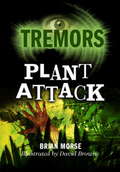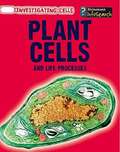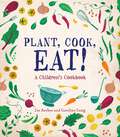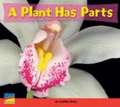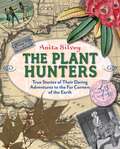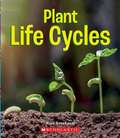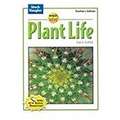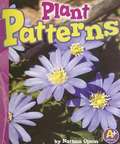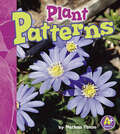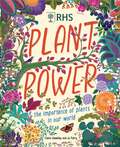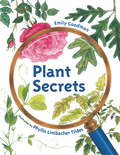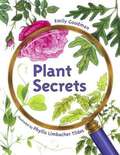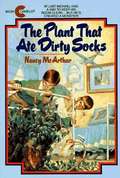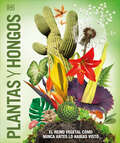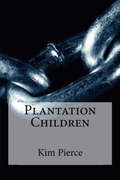- Table View
- List View
Plant Attack (Tremors #102)
by Brian MorseThese ghostly adventures and spine-chilling stories are great for reads for reluctant readers. Written by well-known authors and illustrated by much-loved illustrators, this series will appeal to boys and girls.
Plant Cells And Life Processes
by Barbara A. SomervillThis book explores the features of the plant cell and their life processes.
Plant, Cook, Eat!: A Children's Cookbook
by Joe Archer Caroline CraigFor beginners and green-thumbed foodies, this unusually all-inclusive garden-to-kitchen cookbook is part lesson in gardening and part collection of healthy, delicious, kid-friendly recipes.With vibrant photo-illustrations and clearly organized sections, discover how to plant seeds in patio containers, window boxes, or on an allotment; harvest fruits and vegetables; determine which plant parts are edible; spot pests in the garden; and use home-grown crops to cook everything from bean and bacon spaghetti to polenta chips to tomato, feta, and basil pizza."This effort offers budding young gardeners (and their adults) a comprehensive, hands-on guide to gardening and cooking" — Kirkus Reviews STARRED REVIEW
The Plant Hunters
by Anita SilveyDriven by an all-consuming passion, the plant hunters traveled around the world, facing challenges at every turn: tropical illnesses, extreme terrain, and dangerous animals. They battled piranhas, tigers, and vampire bats. Even the plants themselves could be lethal! But these intrepid eighteenth- and nineteenth-century explorers were determined to find and collect new and unusual specimens, no matter what the cost. Then they tried to transport the plants--and themselves--home alive. Creating an important legacy in science, medicine, and agriculture, the plant hunters still inspire the scientific and environmental work of contemporary plant enthusiasts.Working from primary sources--journals, letters, and notes from the field--Anita Silvey introduces us to these daring adventurers and scientists. She takes readers into the heart of their expeditions to then-uncharted places such as the Amazon basin, China, and India. As she brings a colorful cast of characters to life, she shows what motivated these Indiana Jones-type heroes. In The Plant Hunters, science, history, and adventure have been interwoven to tell a largely forgotten--yet fascinating--story.
Plant Life Cycles (A True Book)
by Mara GrunbaumIncredible Plants series introduces young investigative readers to many types of unusual and typical plants from photosynthesis, how they grow, and ways they survive in extreme environments.
Plant Man: The Life and Art of Makoto Azuma (Fountas & Pinnell Classroom, Guided Reading Grade 6)
by Nicole WalkerFrom Guitars to FLOWERS When a young rock musician struggled to pay his bills, he was forced to take a job doing something he never thought he'd do: work in a flower shop. But that fateful turn of events changed Makoto Azuma's life forever. His job soon evolved into a passion for transforming flowers into art. Now, his amazing and outrageous artwork never fails to surprise and delight audiences around the world. NIMAC-sourced textbook
Plant Patterns (Finding Patterns Ser.)
by Nathan OlsonSimple text introduce different kinds of plant patterns.
Plant Power: The Importance of Plants in our World
by Claire LlewellynPlants are amazing! They are found in every part of the world, growing from tiny seeds into beautiful blooms, gigantic trees and the delicious fruit and vegetables we eat. Plants are vitally important to humans, animals and even the climate, providing food, shelter, medicines and even helping to clean our planet's air and water. This book tells you everything you need to know about plants, from how they grow, reproduce and make their own food to the variety of ways that humans and animals use plants every single day.Readers can find out about plant parts and plant life cycles, pollination, food chains, photosynthesis, seeds and plant uses, such as in food, homes, furniture, musical instruments and medicines. We find out how plants can inspire us and how we need to protect plants so they can help protect us.This book is perfect for children aged 7+.
Plant Secrets
by Emily GoodmanYoung scientists will love this nature mystery that reveals the secrets hiding in seeds, plants, flowers, and fruits throughout the life cycle of various flora. Curiosity will bloom in this introduction to botany and primary nature science. Plants come in all shapes and sizes, but they go through the same stages as they grow. Using four common plants, young readers learn about plant structure and life cycle. Simple text and colorful, detailed illustrations show the major phases of plant growth with each stage holding a &“secret&” for curious readers to guess. Back matter offers more information on each plant, as well as greater detail on each stage of growth.
Plant Secrets
by Emily Goodman Phyllis Limbacher TildesPlants come in all shapes and sizes, but they go through the same stages as they grow. Using four common plants, young readers learn about a plant's life cycles.
Plant Signals: How and Why Plants Communicate (Fountas & Pinnell Classroom, Guided Reading Grade 6)
by Corey FlanniganMysterious Communications When hiking in a forest, we admire a redwood's beauty or a pine tree's fragrance. But what we don't notice are the trees' hidden talents. Trees and other plants can actually communicate with one another in surprising ways—and for fascinating reasons. NIMAC-sourced textbook
The Plant That Ate Dirty Socks
by Nancy McarthurAt last Michael had a way to keep his room clean... but he had created a monster!Norman is a neat freak while Michael, his brother and roommate, is the king of mess! Not until two unusual plants come into their room do these brothers find a common cause. A funny book.
The Plant That Ate Dirty Socks
by Nancy McarthurYummie, Yummie. . . Dirty Socks! Michael's room was always a disaster area, strewn with all kinds of litter -- heaps of papers, piles of crumpled clothes, and dirty socks everywhere. And that was just the top layer! The trouble was, half the room belonged to Michael's brother Norman the neatness nut. It was the battle of the bedroom -- with Norman fighting to keep his spotless territory free from the invasion of Michael's mess. But that was before the appearance of the most amazing plants ever! Suddenly Michael's junk heap disappeared and the room was taken over by the two giant plants that gobbled up socks faster than anyone could supply them! And their appetites were growing bigger every day! When the plant that militant slob Michael grows from his mail-order seeds develops an appetite for dirty socks, Michael and his neatnik brother, Norman, join together to persuade their parents to let them keep the ever-growing-and voracious-greenery.
Plantar semillas: Celebrar la primavera (¡Arriba la Lectura!, Big Book Unit 1 #8)
by Kathryn ClayNIMAC-sourced textbook
Plantas carnívoras: Plantas que comen insectos (¡Arriba la Lectura!, Level O #14)
by Katie SharpNIMAC-sourced textbook
Las plantas me alimentan (¡Arriba la Lectura!, Read Aloud Module 8 #1)
by Lizzy RockwellNIMAC-sourced textbook
Las plantas necesitan agua (¡Arriba la Lectura!, Level K #43)
by Heather HammondsTanto los humanos como los animales dependen de las plantas para alimentarse. Por eso, es importante que las plantas reciban suficiente agua. ¿Cómo obtienen las plantas el agua que necesitan para sobrevivir? NIMAC-sourced textbook
Las plantas que usamos (¡Arriba la Lectura!, Level K #89)
by Lisa ShulmanNIMAC-sourced textbook. Las plantas se usan para hacer libros, ropa y muchas otras cosas. Descubre qué partes de las plantas se usan para hacer las cosas que necesitamos.
Las plantas y el sol (¡Arriba la Lectura!, Leveled Reader Benchmark K-2, Level K #11)
by Thea Franklin Margo BurianNIMAC-sourced textbook
Plantas y hongos (Knowledge Encyclopedia Plants and Fungi!)
by DKExplora el maravilloso mundo de las plantas y los hongos, desde los cactus y las plantas carnívoras hasta los árboles, las flores y los hongos.¿Por qué las flores son coloridas y las frutas son dulces? ¿Cómo captura una planta carnívora a su presa? ¿Por qué pican las ortigas? ¿Cómo convierten los árboles la luz en alimento? Este libro sobre la naturaleza para niños fascinará a los lectores más jóvenes con detalles microscópicos y datos curiosos sobre el reino de las plantas y los hongos.En su interior, encontrarás: Datos, gráficos, líneas temporales e ilustraciones de una amplia gama de temas.Un enfoque visual único de las plantas y los hongos de todo el mundo, gracias a sus impresionantes y detalladas imágenes en 3D.Información valiosa que sirve de apoyo para los estudiantes de ciencias.¡La vida en la Tierra no podría existir sin plantas y hongos! Crean los alimentos que comemos y el oxígeno que respiramos, regulan el clima, proporcionan hábitats para los animales y producen recursos sostenibles que podemos usar para hacer libros, ropa, muebles y casas. Plantas y hongos muestra cómo estos seres vivos son los cimientos de todos los ecosistemas y hacen de nuestro planeta un lugar habitable. ¿A qué esperas para aprenderlo todo sobre los organismos imprescindibles para la vida en la Tierra?Explore the wonderful world of plants and fungi, with everything from cacti and carnivorous plants to trees, flowers, and mushrooms.Why are flowers colorful and fruits sweet? How does a carnivorous plant kill its prey? Why do stinging nettles sting? How do trees turn light into food? This ultimate nature book for children will fascinate young readers with its microscopic detail and amazing facts on the plant world. This all-encompassing nature encyclopedia for kids offers: A whole collection of facts, charts, timelines, and illustrations that cover a vast range of topics.Plants and fungi from around the world shown using amazingly detailed CGIs that entice young readers to dive in and explore.Important STEM topics covered in life sciences curricula.A visual approach using illustrations, photographs and extremely detailed 3D CGI images.Knowledge Encyclopedia: Plants and Fungi! shows how plants and fungi form the foundations of every ecosystem, making our planet habitable. Life on Earth couldn’t exist without plants and fungi. Plants create the food we eat and the oxygen we breathe. They regulate the climate, provide habitats for animals, and produce sustainable resources that we can use to make books, clothes, furniture and houses. Fungi are just as important.
Plantation Children
by Kim PierceTennessee, 1862. Fifteen-year-old Elizabeth Edwards hates her personal slave, Anna. Elizabeth has never given much thought to the plight of the slaves on her father's plantation; instead, she focuses on pretty dresses and horses, and dreams of the young man she wants to marry.But Elizabeth's world collapses when she is told she must marry her cousin to keep the plantation in the family. Elizabeth takes out her anger on Anna, who finally snaps and reveals that Elizabeth and she have the same father. Anna is brutally whipped the next day, and Elizabeth is horrified. When she tries to confide in her mother, she finds her secretly kissing Elizabeth's tutor.Elizabeth now feels she has nothing and nobody. She changes her attitude about Anna and asks her to run away with her. They are overheard by two stable hands, Fred and Sam, who have heard of a safe house on the Underground Railroad. The four of them set off, planning to reach Canada.Will they all make it to Canada alive? Does Anna truly forgive Elizabeth, or is she just using her? Is it possible to find love on the run?
